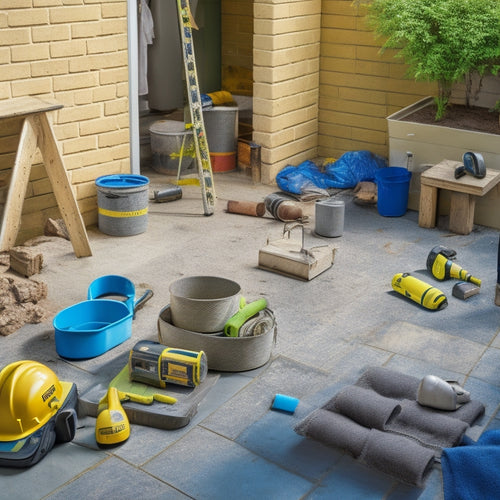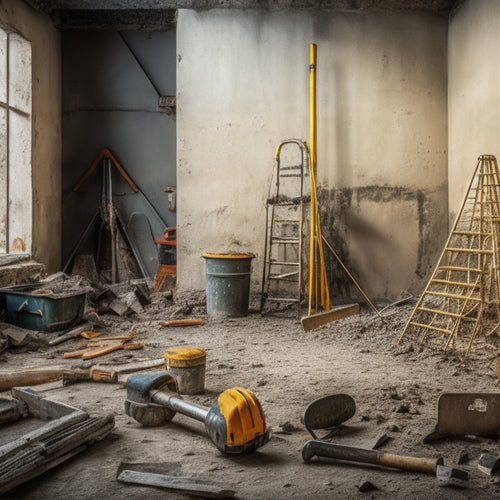
5 Tips for Scaffolding Your Home Renovation
Share
When scaffolding your home renovation, you'll want to start by evaluating your block stucco exterior for cracks, water damage, and wear, prioritizing repairs based on severity. Next, choose the right scaffolding type based on weight capacity, material, and safety features, considering rental options if needed. Make certain the scaffolding is at a comfortable height, with proper platform height and maximum reach. Plan for accessibility by positioning scaffolding for easy access to repair areas, creating a clear path, and identifying potential bottlenecks. Finally, inspect your scaffolding regularly to prevent safety issues and maintain stability, and by following these key steps, you'll be well on your way to a successful renovation.
Key Takeaways
• Inspect your exterior stucco before renovations to identify and address cracks, water damage, and wear, focusing on areas around windows, doors, and corners.
• Choose the right scaffolding type based on weight capacity, material, and safety features, considering aluminum options for lightweight durability.
• Ensure proper scaffolding height to allow comfortable reach without overstretching, adhering to height regulations and guidelines for safety.
• Plan for scaffolding accessibility by positioning it for easy access to repair areas, assessing obstacles, and creating a clear path to work areas.
• Inspect scaffolding regularly, conducting daily checks on foundation, frames, planks, guardrails, and access points to maintain safety and prevent major issues.
Assess Your Block Stucco Exterior
Before commencing your home renovation project, thoroughly inspect your block stucco exterior to identify any cracks, water damage, or signs of wear that require attention.
You don't want any surprises down the line, like finding out you need to replace the entire stucco surface because you overlooked a tiny crack.
Take a close look at the walls, paying attention to areas around windows, doors, and corners, where damage often occurs.
Make a note of any issues you find, and prioritize them based on severity.
Choose the Right Scaffolding Type
Now that you've identified any issues with your block stucco exterior, you'll need to select the right scaffolding type to confirm safe and efficient access to those areas requiring repairs or replacement. Don't worry, we've got you taken care of!
When choosing a scaffolding type, consider the weight capacity, material, and scaffolding safety features. You'll want to select scaffolding materials that can support your weight and any tools or materials you'll need to transport. Aluminum scaffolding is a popular choice due to its lightweight yet durable design.
When it comes to scaffolding safety, look for features like sturdy handrails, secure footing, and a stable platform. You'll also want to verify the scaffolding is designed for your specific project, whether that's a single-story or multi-story renovation.
Consider renting scaffolding if you're not familiar with the setup process or don't have the storage space. Remember, safety should always be your top priority when working at heights. By choosing the right scaffolding type, you'll be able to tackle your renovation project with confidence and peace of mind.
Ensure Proper Scaffolding Height
When positioning your scaffolding, make certain to set the platform height so that you can comfortably reach the area requiring repair or replacement without overstretching or standing on tiptoes. You don't want to be that person who ends up with a pulled muscle or, worse, a nasty fall. Scaffolding safety is no joke, folks!
To ensure you're meeting height regulations, refer to the following table:
| Platform Height | Maximum Reach |
|---|---|
| 2-4 ft | 6-8 ft |
| 4-6 ft | 8-10 ft |
| 6-8 ft | 10-12 ft |
| 8-10 ft | 12-14 ft |
| 10-12 ft | 14-16 ft |
Plan for Scaffolding Accessibility
You'll want to strategically position your scaffolding to secure easy access to all areas of the repair or replacement site, taking into account any obstacles, such as landscaping, electrical outlets, or other structural elements.
A well-planned scaffolding layout is essential for efficient work progression and, more importantly, scaffolding safety. Imagine having to awkwardly climb over bushes or dodgy wiring just to get to that one spot that needs fixing – not exactly the most thrilling or safe experience!
To avoid such mishaps, take the time to assess your property's unique challenges and plan your scaffolding layout accordingly. Identify potential bottlenecks and consider alternative access points.
Make sure that your scaffolding provides a clear, obstacle-free path to all areas of the work site. Don't forget to account for any overhead obstructions, like tree branches or power lines, that could interfere with your scaffolding setup.
Inspect Scaffolding Regularly
Every morning before climbing onto the scaffolding, inspect it thoroughly to guarantee all components are securely in place and functioning as intended. This daily ritual is essential for scaffolding safety, and it's not just about checking boxes on a to-do list.
You're ensuring your own safety and the safety of others on site. Start by examining the scaffolding's foundation, making sure it's level and stable. Then, move on to the frames, checking for any signs of damage or wear. Don't forget to inspect the planks, guardrails, and access points – these are vital components that can make or break your renovation project.
Regular maintenance checks will help you identify potential issues before they become major problems. Remember, scaffolding safety is no joke, and it's always better to be proactive than reactive. By incorporating these daily inspections into your routine, you'll be able to tackle your home renovation project with confidence and peace of mind.
Frequently Asked Questions
Can I Reuse Scaffolding From a Previous Project or Rental?
Before reusing scaffolding from a previous project or rental, you're wise to inspect it with a fine-tooth comb.
Check for worn or damaged parts, and make certain it's been properly maintained. Safety should be your top priority, so don't skip this step!
You'll also want to verify it's been properly stored and transported to prevent damage.
Remember, scaffolding safety is no joke - it's your life on the line.
How Do I Protect My Landscaping From Scaffolding Damage?
As you erect scaffolding, your lush landscape looks on, trembling like a nervous wreck.
Don't let your renovation dreams turn into a garden nightmare!
You'll want to shield your shrubs and flowers from scaffolding damage.
Set up scaffolding barriers to prevent crushing and scraping.
Lay down protective coverings, like plywood or mats, to distribute the weight.
You'll be the landscaped lawn hero, saving your greenery from certain destruction!
Are There Any Scaffolding Options for Uneven or Sloping Roofs?
You're tackling a renovation with an uneven or sloping roof, huh? Don't worry, you've got options!
For scaffolding stability on tricky roofs, consider using adjustable scaffolding systems or modular units that can be customized to fit your roof's unique shape.
These systems provide secure roof access, even on steep or irregular surfaces.
You'll be scaling new heights in no time - literally!
Can I Have Multiple Levels of Scaffolding for a Single Project?
You're wondering if you can have multiple levels of scaffolding for a single project?
Absolutely! In fact, it's a common practice to have multi-tiered scaffolding for complex projects.
Just make certain you're prioritizing scaffolding safety by using sturdy scaffolding materials, like heavy-duty frames and secure decking.
With proper planning and execution, you can create a multi-level masterpiece that's both efficient and safe.
Do I Need to Hire a Professional to Assemble the Scaffolding?
You're wondering if you need to call in the pros to assemble your scaffolding. Honestly, it's not a DIY-friendly task, especially when scaffolding safety is on the line.
Unless you're familiar with assembly guidelines and have experience with complex structures, it's best to hire a professional. They'll guarantee your scaffolding is erected correctly, so you can focus on your project, not worrying about it all coming crashing down - literally!
Conclusion
You've finally reached the finish line of planning your home renovation scaffolding!
Now, imagine a towering structure of steel and wooden planks, wrapping around your house like a protective cocoon, shielding you from the chaos of construction.
With these 5 essential tips, you'll be safeguarding yourself and your crew from catastrophic accidents, ensuring a smooth renovation process that's more efficient than a Swiss clockwork.
Related Posts
-

7 Patio Safety Tips for DIY Renovation Projects
As you begin your DIY patio renovation project, prioritize safety by evaluating the worksite for tripping hazards and...
-

Why Renovation Waste Disposal Harms the Environment
When you undertake a renovation project, you're contributing to a staggering problem: renovation waste disposal, whic...
-

What Tools to Rent for Block Wall Renovation
When renovating a block wall, it's vital to have the right tools for the job. You'll need demolition tools like pry b...


